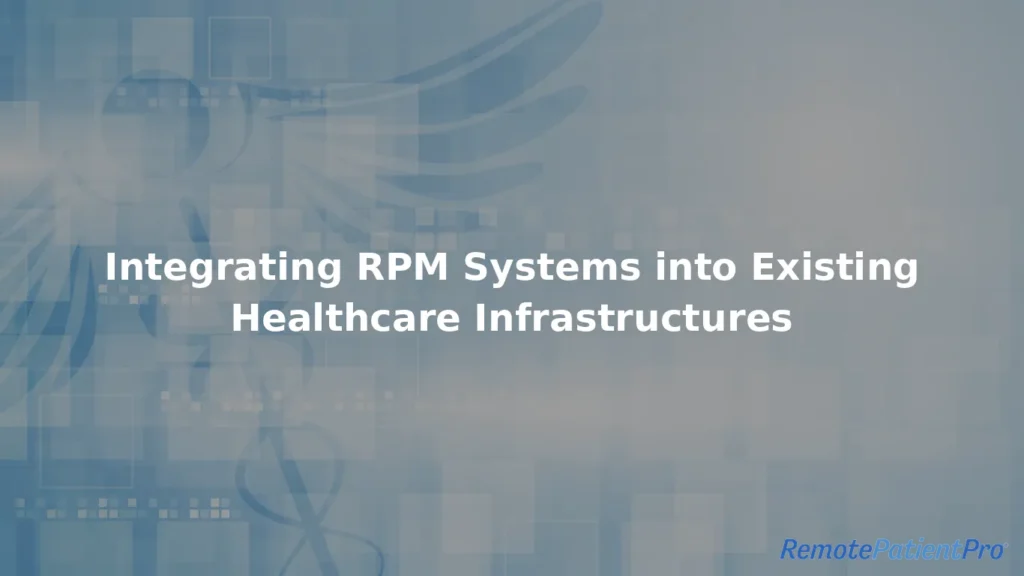Integrating RPM Systems Into Existing Healthcare Infrastructures
As healthcare organizations like Federally Qualified Health Centers continue to adopt digital health solutions, integrating remote patient monitoring (RPM) systems into existing healthcare infrastructures will become essential. Effective integration involves seamless data sharing, optimized workflows, and improved patient outcomes. However, healthcare providers may hesitate to adopt RPM because they’ve heard about some platforms failing to connect with electronic health records (EHRs), telehealth services, and other tools for care coordination.
Thankfully, that’s no longer the case. A well-integrated RPM system enables real-time patient monitoring, encourages early health interventions, and reduces hospital readmissions, making it a critical component for value-based care.
Key Considerations for RPM Integration
Successful RPM integration will be reflected in how well a solution communicates with your existing software and workflows. Organizations should evaluate:
- EHR Compatibility – The RPM platform should sync with leading EHR systems to share the appropriate patient data, identify trends, and make it easier to coordinate care.
- Scalability and Flexibility – The solution should accommodate growing patient populations and evolving care models.
- Data Security and Compliance – RPM must comply with HIPAA and use secure encryption to protect patient information.
- Device Interoperability – A comprehensive RPM solution should support a range of devices, including blood pressure monitors, glucose meters, pulse oximeters, and wearables.
- Automated Alerts and Notifications – Integrated alerts help providers identify at-risk patients and intervene before conditions worsen.
Steps to Integrate RPM Systems Successfully
Assess Your Center’s Readiness
Before deploying an RPM system, healthcare organizations must evaluate their EHR capabilities, IT infrastructure, and workflow compatibility. Conducting a readiness assessment helps identify potential integration challenges.
Select an RPM Platform With EHR Integration
Choosing an RPM solution that seamlessly connects with major EHR systems will ensure real-time data sharing and minimize administrative burdens. For instance, TriageLogic’s RemotePatientPro™ integrates with Epic, Cerner, Allscripts, and other leading healthcare systems.
Implement API-Based Data Exchange
Using API-driven integrations will allow for secure and efficient data transfer between RPM devices and your center’s platforms. This means that care teams will have access to accurate, up-to-date patient data without being held up by manual entry.
Train Clinical Staff and Patients
To get the most out of RPM, clinicians, nurses, and care coordinators must be trained on system functionality, data interpretation, and patient engagement strategies. Educating patients on how to use remote monitoring devices will encourage them to maintain those devices for better health outcomes.
Monitor and Optimize Performance
Healthcare organizations should track RPM usage, patient engagement, and clinical outcomes to refine the integration process. Regular assessments will identify any workflow inefficiencies and help your team improve its care.
How Our RPM Platform Streamlines Integration
RPP’s remote patient monitoring solution is designed for easy integration with existing healthcare infrastructures.
- Seamless EHR Compatibility – It connects with leading EHR systems.
- Automated Data Syncing – It reduces manual documentation and administrative workload.
- Customizable Alerts and AI-Driven Insights – It helps providers proactively manage patient health.
- HIPAA-Compliant Security – It offers end-to-end encryption to protect patient data and privacy.
Enhance Your Care With RPM
Integrating RPM into your healthcare system can reduce hospital readmissions, improve chronic disease management, and enhance care coordination. RPP’s scalable, EHR-compatible RPM platform enables organizations to deliver proactive, data-driven care with ease.
Ready to integrate RPM? Schedule a demo to see how it can benefit your team.

